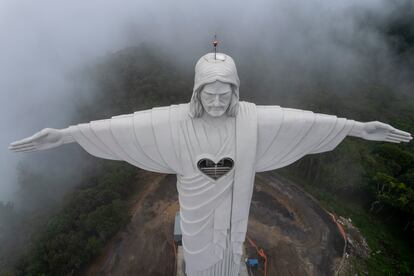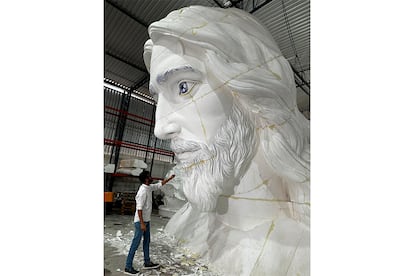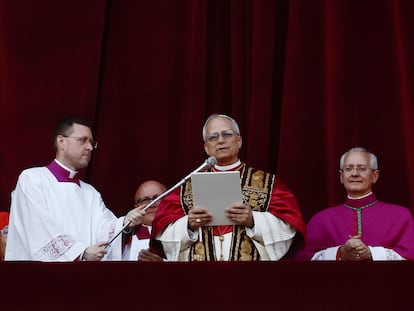Brazil and the rush to build the world’s largest Catholic statue
Monuments are multiplying across the country just as the number of Catholics falls to historic lows, due to the rise of Evangelical Christians

The image of Christ the Redeemer, with his arms wide open above Rio de Janeiro, is one of Brazil’s quintessential postcards. However, the country’s most famous statue has a long list of competitors.
Brazil is currently experiencing a frenzy to build the world’s largest Catholic statue. A multitude of projects are spread across the country, depicting saints and the Virgin Mary, along with more or less successful imitations of Christ the Redeemer. The phenomenon coincides with a time of undeniable decline of Catholicism in the nation, which has the largest Catholic population of any country in the world.
In 2010, Catholics accounted for 65.1% of the population. But by 2022, they had fallen to 56.7%, dropping from 105.4 to 100.2 million Brazilians. According to the most recent official census data, published earlier this month, this is the lowest number on record.
Every year, more than 430,000 Brazilians have steadily left the ranks of the Roman Catholic Church. And yet, you wouldn’t think so by looking at monuments such as Christ the Protector, in the southern Brazilian town of Encantado. Despite having only 20,000 inhabitants, Encantado has the world’s largest statue of Christ: weighing 1,700 tons and standing 140 feet tall, it is 42 feet taller than the famous Christ of Rio.
Christ the Protector was financed entirely through donations, although this was an exceptional case. Most Catholic statues being built in Brazil are paid for with public funds, provided by the municipalities themselves. Typically, it’s mayors seeking a tourist magnet (as well as the votes of parishioners).
Erecting a statue that’s at least 98 feet tall costs around five million reais, or almost $1 million. One of the most prolific sculptors in the sector, Ranilson Viana, explains this to EL PAÍS over the phone. Self-taught, he came to his trade by chance. Just a few years ago he was working as a fruit seller. Today, he has a team of 40 people, as well as a folder full of commissions.
“We’re building the largest sculpture in Brazil: a [190-foot-tall] Saint Anne. That will break the record; it will have an elevator inside,” he says enthusiastically over the phone. Currently, he’s building five statues that are each over 130 feet tall. He notes that demand has skyrocketed after the Covid pandemic; his workshop can’t keep up. They make fiberglass monuments that are very realistic-looking, and some are painted in bright colors.

Most of the statues that Viana builds are placed in small towns across the northeast of the country, which is historically the most Catholic part of Brazil, as well as the poorest. Viana is accustomed to refuting criticism from those outraged by the use of public resources in places where schools and hospitals are precarious, and where there’s often a lack of funds even to pave the streets. He defends his art as a stimulant for sleepy spots on the map. Religious tourism is no small feat: often, a statue is the first step toward creating small theme parks of faith.
In the city of Santa Cruz, located in the state of Rio Grande do Norte, a 183-foot-tall statue of Saint Rita of Cascia receives 100,000 pilgrims every May, filling hotels, restaurants and shops. The plan now is to build a cable car between the patron saint of impossible causes and the city’s historic center. The mayor is asking the local legislators to allocate funds to complete the project as soon as possible.
The fact that the furor over statues is occurring at a time when Brazilian Catholicism is waning may be symptomatic. For Suzana Moreira, a theologian and specialist at the Institute of Religious Studies (ISER), there are plenty of indications that the constructive impulse has something of a strategy behind it:
“What’s the far right’s [link] to Catholicism [in Brazil]? It’s rarely discussed; it’s always the far right’s project with Evangelicals […] I wouldn’t be surprised if all these cases were part of the Catholic far right’s dispute, as they fight for a space in the most rural communities and [attempt to] mobilize the grassroots.”
“The far right understood long ago that the grassroots are won over through spirituality,” Moreira continues. “And, in recent decades, Catholicism has somewhat lost its connection with the grassroots and the peripheries.”

The truth is that Brazilian Catholicism struggles to compete with the enormous pressure from Evangelical churches, which are present everywhere and draw heavily on disillusioned Catholics. Over the past 12 years, the population of Evangelicals has grown by five percentage points and now represent 27% of the population, or 47.4 million Brazilians. Furthermore, unlike the Catholic community (which includes many non-practicing Catholics), Evangelicals tend to be much more active in their faith. Proselytism and the hunger to occupy every space (including public ones, given the very strong Evangelical bloc in the Brazilian National Congress) are in their DNA. This is especially the case in the neo-Pentecostal churches, the most recent ones to emerge.
In contrast to their dynamism, the Roman Catholic Church has experienced years of stagnancy, although the census also shows that while the number of Catholics continues to decline, the population is no longer falling so rapidly. For Moreira, this may be attributed to the deceased Pope Francis: he visited Brazil in 2013 and, throughout his tenure, emphasized the pastoral vocation.
The use of monuments (the larger the better) could be part of this renewed momentum. Such a strategy also touches on a particularly sensitive issue for Evangelicals, who don’t venerate images. And, within the Evangelical community, cases of religious intolerance toward what is considered to be a form of paganism are not uncommon.
For Catholics, reclaiming images is a way to boast. “We live in very media-driven times. Creating ‘Instagrammable’ things is a way to win over the people. In that, Catholicism has an advantage; it knows how to use symbolic elements for this type of dispute,” the theologian adds.
In this sort of tropical Counter-Reformation 2.0, the pace never stops. In São Miguel Arcanjo, 110 miles from São Paulo, a statue of the saint that the municipality is named after (St. Michael the Archangel) is being built next to an esplanade that’s intended for open-air masses. It will accommodate 12,000 people. The statue isn’t ready yet, but for now, its head – located in the middle of the vacant lot – is already attracting hundreds of pilgrims. When finished, the statue will be 230 feet tall and, according to its proponents, will be the largest Catholic statue in the world. The designer is sculptor Markus Moura, another Brazilian specialist in building giant statues.
Viana isn’t daunted, however. He reveals that he already has plans to break that record. “If they make that [statue], it would be great… but we already have a [262-foot] project in the works: Our Lady of the Immaculate Conception, in the state of Alagoas.”
Sign up for our weekly newsletter to get more English-language news coverage from EL PAÍS USA Edition
Tu suscripción se está usando en otro dispositivo
¿Quieres añadir otro usuario a tu suscripción?
Si continúas leyendo en este dispositivo, no se podrá leer en el otro.
FlechaTu suscripción se está usando en otro dispositivo y solo puedes acceder a EL PAÍS desde un dispositivo a la vez.
Si quieres compartir tu cuenta, cambia tu suscripción a la modalidad Premium, así podrás añadir otro usuario. Cada uno accederá con su propia cuenta de email, lo que os permitirá personalizar vuestra experiencia en EL PAÍS.
¿Tienes una suscripción de empresa? Accede aquí para contratar más cuentas.
En el caso de no saber quién está usando tu cuenta, te recomendamos cambiar tu contraseña aquí.
Si decides continuar compartiendo tu cuenta, este mensaje se mostrará en tu dispositivo y en el de la otra persona que está usando tu cuenta de forma indefinida, afectando a tu experiencia de lectura. Puedes consultar aquí los términos y condiciones de la suscripción digital.
More information
Archived In
Últimas noticias
Most viewed
- Sinaloa Cartel war is taking its toll on Los Chapitos
- Oona Chaplin: ‘I told James Cameron that I was living in a treehouse and starting a permaculture project with a friend’
- Reinhard Genzel, Nobel laureate in physics: ‘One-minute videos will never give you the truth’
- Why the price of coffee has skyrocketed: from Brazilian plantations to specialty coffee houses
- Silver prices are going crazy: This is what’s fueling the rally










































